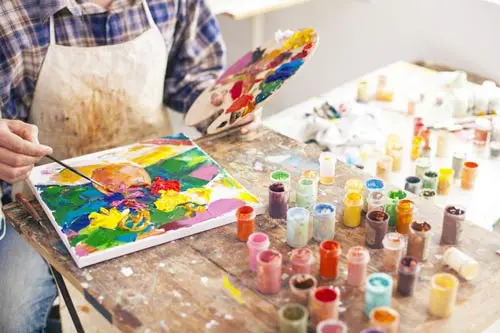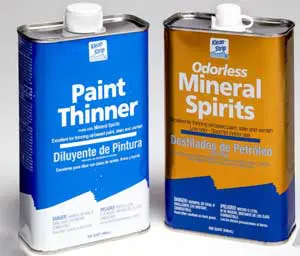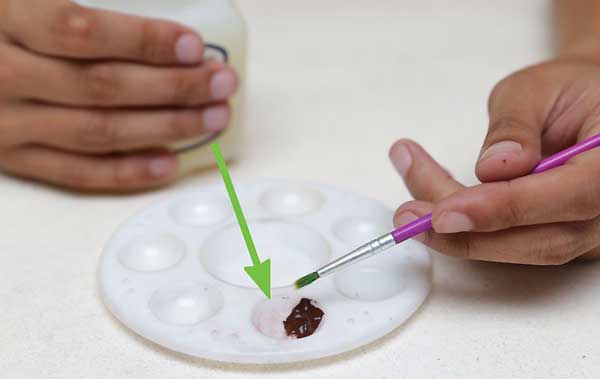How To Thin Acrylic Paint In Different Ways?
Painters express their emotions and concepts through painting. They use shapes, colours, tones, lines and textures as an element to generate movement, light and space on a flat two-dimensional surface.
In the late 19th century, a new type of paint by the name Acrylic was introduced. It enables the artist to control the texture, appearance and depth of the paint using different mediums. For these reasons, it quickly become a popular choice among the artists.
It can be thinned to attain variety in colour and consistency; which assists in achieving wonderful effects. Thus, thinning makes the project more luminous and attractive.
Thinning the paint can be a daunting task, but is doable. More so, there are different methods of thinning.
Ways of Thinning Acrylic Paint

Acrylic paint is made up of pigments that are suspended in acrylic polymer emulsion. In this paint, water works as an extender and helps the paint to spread easily.
You can apply the paint directly from the tubes they come in, or you can thin them to provide a lighter effect on your masterpiece. The good thing about the paint thinning processes is that once you master them completely, they become super easy to apply.
If you properly follow the methods given below, you’ll surely be an expert when it comes to thinning them. We will now discuss some useful and popular thinning methods which are tested and can be applied effectively.
Related: Get A Right Gouache Paint From Our List
Water Method
Water is the most common substance available in the world. Obviously, it is the cheapest option to go. However, it is worth mentioning that you can't just pour water carelessly, rather you have to control it down to get the desired result.
Many paint producers suggest that it is ideal to mix 50% of water to the paint. On the other hand, expert artists suggest that you should add no more than 30%.
However, you do not need to follow any specific percentage ratio if you paint on an absorbent surface such as on water colour paper or on wood that does not have any primer on it. There is also no need to apply this percentage rule on canvas which doesn’t have any gesso.
Remember, over soaking the colour with water decreases the overall quality of your art as it results in peeling the paint.
To smoothly execute the thinning process, mix your paint with water either on a different palette or in a small cup. This will assist you to stop any leakage of the water.
Additionally, you can dip the brush in a bowl of fresh water and then slowly put the water drop from your paintbrush onto the paint. Gently mix the water using your brush, until you get your desired mixture.
Precautions
- 1Use pure water with the paint. Because impure water can spoil your art surface as dirt particles from such water may contain harmful chemical substances.
- 2Always put a little amount of paint to the palette. As acrylic paint dries within 30 minutes, taking out an excessive amount of paint from the tube can result in waste.
Thinning Medium Method
According to some painters, using a thinning medium is the best way to thin acrylic paint. A beginner should avoid the water method because one needs to be very careful when mixing water with paint. A slight mistake can ruin your paint.
An acrylic medium such as airbrush can be a good alternative to water. Airbrush medium is almost as thin as water. Simply pour some airbrush medium on a bowl and add the paint with it. This will provide you with a smooth layer of thinned paint instantly.
The difference between water and a medium is that by using medium you are not decreasing or wreaking the bonding strength as it has the acrylic binder in it.
Upon using water, you end up with what’s called an under bound paint film. It means that there is not enough binder to keep that paint permanently on the canvas. But, in the case of an acrylic medium, you will create a stable paint film because of the interlocked binders.
Unlike water, you need not to be anxious about peeling your colour or making it too much light. The underlying reason is that you don't have to be concerned about the mixing ratio. Resultantly, there is a very little chance of chipping or peeling of the paint.
The main advantage of an acrylic medium is that it holds the painting on the canvas for a very long time. Furthermore, the medium helps the next layers of paint to stick to it.
Precautions
- 1Buy good quality thinning mediums for the job even if it costs more.
- 2Try to use your thinner according to the instruction manual.
Spirits and Paint-Thinners


Besides water, a lot of professionals prefer to use chemical thinners such as rubbing alcohol and acetone to thin their paints.
Whether a stylistic choice or a personal necessity, chemical thinners should always be used according to the instructions on the bottle or the directions given by the person selling it to you.
You can still drop by your local art stores for a better understanding of the chemical makeup of the products you are buying and the complimentary thinner/paint combinations.
It is best to consult with an expert when dealing with strong chemicals and not take names off the internet.
Most artists online, although well-meaning, might be using brands and chemicals local to their region which might not be so readily accessible to you.
The Process
Like with water, when starting, it is best, to begin with, a small amount of product. A rule of thumb is to buy thinners and acrylics from the same manufacturers as a lot of them will make products specifically designed to complement each other.
If not an option, ask the store clerk for recommendations when buying your paints. When ready with your chemical thinner of choice, add it to your acrylic paint according to the directions.
You can always experiment with your paint to find what works best, but it is advised you do not go heavy-handed with the paint as too much of some solvent may disrupt the quality of the color.
Use Household Products as Thinners
Although not for everyone, a lot of seasoned acrylic users have developed their thinners from household chemicals, such as rubbing alcohol and acetone from cleaning products.
It is worth mentioning that these users usually have a clear understanding of their acrylic paints and the chemical makeup and percentage of their DIY thinners.
This is not a recommended method of acrylic thinning for beginners, and it usually takes a lot of experimentation to get to the correct combinations before you can start painting.
Additional Tips For Those Who Are Not Getting The Desired Result
If you fail using the above methods then you should examine the whole process carefully. The canvas that you are using may have a non-traditional surface like metal, wood, etc. In this situation, apply gesso on the surface first.
Gesso is a primer with the special ability to stick to most surfaces. It gives an excellent base for your thinned acrylic to attach. You should ensure that you are using the right type of Acrylic painting brush.
To Sum Up
Acrylic paint has different attributes and use. Though it is water soluble, it turns into a water-resistant paint upon drying. What's more fascinating about the paint is that it dries very quickly which makes it an ideal choice of paint to use in crafting and construction.
Just follow any of the above-mentioned methods to thin your paint and yield the best result.
Other Accessories:
>> We Created Top 10 Kneaded Eraser For Artist
>> Get A Light Boxes for Artists

